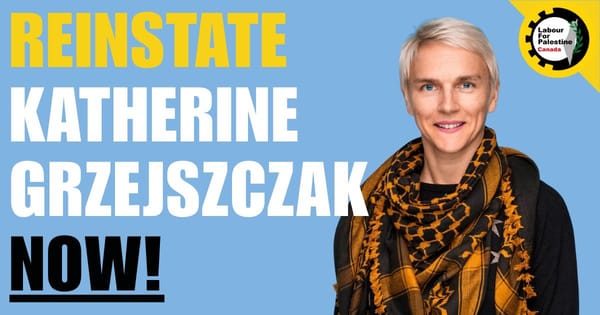The holidays are over, 2022 is done and gone, and a fresh year is upon us. What are the prospects for a renewed labour movement in 2023?
First, let’s take a moment to review some of the highlights of last year. While labour achieved important gains at the bargaining table, through legislation and in the streets, much of the fight was unfortunately rearguard, aimed at countering government repression and fending off employer attacks. Still, there were achievements to celebrate.
Without a doubt, the most memorable win for labour in 2022 was CUPE Ontario education workers’ protest against Bill 28, the so-called Keeping Students in Class Act. The fight to preserve collective bargaining rights in the face of Ontario Premier Doug Ford’s unprecedented use of the “notwithstanding clause” rallied much of the national labour movement. In an all-too-rare episode of solidarity and cooperation, union leaders pledged coordinated action against the government’s draconian legislation. In response, Ford blinked.
Also in Ontario, the courts finally struck down Ontario’s Bill 124, ending three years of unconstitutional wage suppression. This victory followed the valiant fight of public sector unions, most notably the Ontario Nurses Association, against wage restraint. Arguably, greater use of direct member organizing and more assertive tactics might have been used to build worker and public opposition to challenge Bill 124, rather than largely relying on a legal strategy. Nevertheless, seeing the bill struck down was welcome and inspiring. Unfortunately, the struggle continues now that the Ford government has appealed the Superior Court’s decision.
In the legislative arena, new paid sick days for workers in the federal private sector finally came into force last month, while workers in British Columbia won a similar reform in January 2022. A temporary doubling of the federal GST rebate provided much-needed aid to low-income families, while minimum wage increases in several provinces raised the floor for non-union workers. As well, a new bill to protect workers’ pensions when a company goes bankrupt passed in the House of Commons and will now go before the Senate.
At the bargaining table and on the picket line, results were mixed. At times, it seemed class struggle was making a resurgence and commentators in the mainstream media took notice. Strikes in grocery warehousing, logistics and cleaning services managed to force significant wage improvements for workers in desperate need of a raise. Yet with inflation raging, wage settlements in new collective bargaining agreements — while above their average in previous years — continued to lag inflation considerably.
Strikes at post-secondary institutions, such as McMaster and Dalhousie universities, saw adjunct faculty and graduate student workers continue the fightback against the underfunding of higher education and the growing reliance on precarious labour. Earlier in the year, the union drive at Chapters-Indigo represented a Canadian twist on the wave of retail organizing seen in the United States.
Union coverage in Canada, however, continues its downward trend. Despite an apparent upsurge in support for unions, there has thus far been no appreciable increase in the share of workers who are union members. Could 2023 be the year where renewed interest in unionization finally shows up as growth in union density?
Admittedly, data on new union certifications trail votes on the ground by several months. The wait for accurate figures, combined with the fact that the adequacy of data collection and reporting varies across provincial labour boards, makes it difficult to get a firm handle on shifting labour dynamics in real time. However, throughout late 2021 and 2022, there was anecdotal evidence that some unions were experiencing a noticeable growth in interest from workers, with a few, such as the Laborers International Union of North America in British Columbia and the Yukon, reporting considerable increases in membership. Some of this was undoubtedly the result of the B.C. NDP government passing card-check unionization, after sustained pressure from the labour movement in that province.
Organizing among young workers and those in sectors not typically represented by unions, such as food services and retail, has clearly shot up since the pandemic. Some of this growth might be the result of what Zak Vescera at The Tyee calls “the Starbucks effect,” i.e., a spillover from the high-profile organizing of some 250 Starbucks stores in the U.S. last year.
At the same time, a sober assessment of 2022 forces us to contend with the limitations of organizing under the Canadian version of the ‘Wagner Model’ of single worksite bargaining. Much greater financial and political commitment from established unions will be required to make 2023 the year the labour movement begins to reverse the decline in density.
It is, however, promising that new leadership in some unions has shown signs of renewed organizing among members and a greater willingness to flex labour’s muscle. Lana Payne, the new president of Unifor, Canada’s largest private sector union, has struck a noticeably more militant tone than her scandal-plagued predecessor. At OPSEU, JP Hornick represents a shift to a more progressive and member-driven union. It was notable that OPSEU leadership called their education members off the job in solidarity with CUPE in Ontario during the two days of protest in early November. With many collective agreements expiring in 2023, in both the public and private sectors, several unions could be poised to make gains if the requisite organizing work is done prior to bargaining.
Of course, 2022 was also the year of the so-called “labour shortage.” A relatively tighter labour market should have provided workers and unions with more breathing room to raise wages and improve working conditions. Although nominal wages did increase faster than their annual average for the past decade or so, inflation took a considerable bite out of workers’ real purchasing power. A low unemployment rate and high job vacancies, on their own, were simply not enough to undo the structural weakness of organized labour — weakness that has been decades in the making.
With the Bank of Canada and governments across the board abandoning their flimsy commitments to “build back better” and run a hot economy with expanding growth and rising wages, the window for workers to make gains seems to be closing quickly.
The business class and their organizations of course have also been hard at work, attempting to use the “labour shortage” as an opportunity to roll back worker protections — from weakening labour standards and collective bargaining rights, to pushing more youth and seniors into the workforce. For example, the U.S. National Federation of Independent Business and local business associations have been lobbying to weaken child labour laws in several states. Be on guard for employers in Canada looking to increase the number of hours teenagers are permitted to work and thus to make low-wage employers’ more dependent on working-class youth.
It appears governments have also largely bought into the business narrative about labour shortages. While federal and provincial governments might not provide business with all the regulatory concessions they would prefer, their commitment to ramping up immigration, particularly when it comes to low-wage workers, could serve as a considerable wage suppressant.
For months employers across industries have been calling for greater access to cheap labour from abroad and the federal Liberals have responded by loosening regulations in the Temporary Foreign Worker Program and promising to significantly increase the number of new immigrants arriving in Canada. Instead of allowing labour market tightness to redound to the benefit of workers, the government is choosing to use immigration to release some of the pressure on employers.
It’s unfortunate that labour and the left wasn’t able to harness concerns about labour shortages to workers’ advantage. Instead, governments caving to employer pressure look likely to undermine the positive economic impacts of a tight labour market. When bosses can’t rely on a ready supply of cheap labour, they are incentivized to invest in new technologies and improve the productivity of labour. This tends to be a progressive dynamic, particularly in sectors long notorious for weak investment, stagnant productivity and low wages. Higher productivity businesses can then afford to pay higher wages.
Furthermore, labour market tightness can change the bosses’ calculus in more subtle ways, for example, by discouraging layoffs even when demand slackens and encouraging employers to devote greater resources to training and employee retention. As economist J. W. Mason points out, “A business that can’t count on quickly hiring workers with whatever skills are needed has to focus more on developing and holding on to the workers it has.” Although interest rate hikes have softened the labour market somewhat, unemployment remains low. It’s therefore not too late for unions to change the script when it comes to the so-called labour shortage.
Typically, successful cycles of union organizing follow periods of economic growth and expansion. When workers feel more financially stable and confident, they are more likely to join together and take collective action. That we haven’t seen any appreciable uptick in unionization over the post-pandemic expansion is therefore concerning, particularly as recession looms in 2023. But the chance to make union renewal a reality has by no means passed.
At this point, I think it’s safe to say that hopes for a revitalized labour movement in 2023 are aspirational, which is not necessarily a bad thing. It simply means that there’s plenty of work to do. Let’s make this labour’s year.







